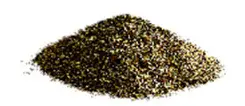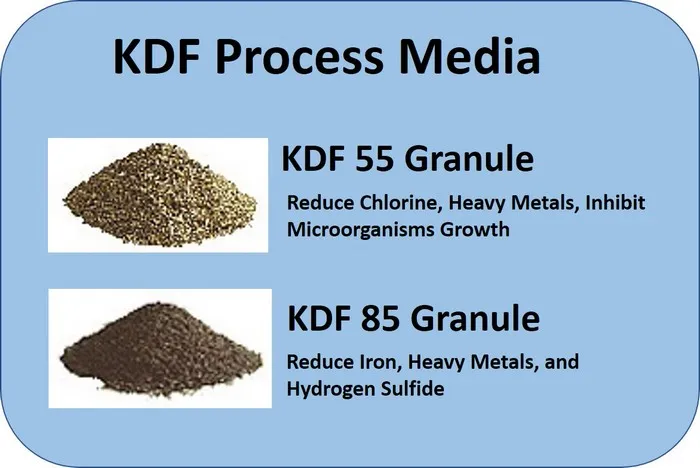If you are researching a water filtration system for your home or office, it’s not surprising that you may come across the term “KDF media”, so you may be curious about what this media is and why it’s used in water filters.
In this article, we will discuss what is the KDF filter media, how it works in water filtration, and why they are so popular in water treatment applications.
What is KDF Filter Media

KDF stands for Kinetic Degradation Fluxion, it’s a filter media that contains high-purity copper-zinc granules to reduce contaminants in water through a redox reaction – oxidation or reduction.
The KDF process media is often used in water treatment solutions to reduce heavy metals, hydrogen sulfide, and chlorine.
The Kinetic Degradation Fluxion technology was developed in 1984 by KDF Fluid Treatment, Inc in the United States and was patented by Don Heskett in 1987.
The KDF filter media is certified by NSF International against Standard 61 and meets EPA and FDA standards for levels of copper and zinc in drinking water.
Due to the effectiveness in water filtration, the KDF process media are often used for water pretreatment processes on households, commercials, and industrials.
Besides, the KDF media are also a better alternative to silver-impregnated systems as the silver could be toxic if not maintained well and is expensive than KDF media.
What are the Forms of KDF Process Media
KDF process media is available in 4 forms, which are:
- KDF 55 granules
- KDF 85 granules
- KDF-F fine mesh granules
- KDF-C coarse mesh granules
KDF 55 Granules
The KDF 55 granules are used to reduce and remove soluble heavy metals and chlorine contaminants from water.
They are commonly used in water filtration systems like multi-stage water filters, faucet filters, and shower filters.
KDF 85 Granules
The KDF 85 granules are used to reduce and remove hydrogen sulfide and iron contaminants from water.
KDF-F Fine Mesh Granule
This form of kinetic degradation fluxion is often used to blend into other media such as activated carbon blocks to improve filtration performance.
KDF-C Coarse Mesh Granules
The KDF-C coarse mesh granules are used to reduce and remove soluble heavy metals and chlorine contaminants from water.
How Does KDF Media Work?
When the water flows through the KDF filter media, the combination of the high-purity copper and zinc produces an electrochemical reaction which exchanges the electrons with the contaminants to convert them into harmless substances.
The process is called redox reaction, which involves transferring of electrons between molecules to form new elements.
What Does KDF Water Filter Media Remove?
KDF filter media can reduce or remove lead, mercury, iron, hydrogen sulfide, calcium carbonate, magnesium, chromium, chlorine, bacteria, fungi, algae, and more.
By incorporating the KDF media with Activated Carbon filter and sediment filter, the combination can effectively remove a wider range of harmful contaminants.
As the KDF media can function effectively under high water temperature, this makes them an excellent choice for hot water filtration like shower filters.
How KDF Water Filter Remove Contaminants?
KDF filter is capable in removing heavy metals, iron, hydrogen sulfide, and chlorine in water, and here’s how it does:
How KDF Filter Remove Chlorine
KDF 55 media filters can remove more than 99% of chlorine by transforming the free chlorine into harmless water-soluble chloride ions through the reduction chemical process.
During the redox process, the KDF media will transfer two negatively charged electrons to chlorine molecules to reduce them to chloride (lower oxidation state), which is highly soluble and harmless.
How KDF Filter Remove Iron
The KDF 85 filter media can effectively remove over 90% of Iron contaminants from water.
In the Iron removal process, the KDF 85 filter media is used as a catalyst to convert ferrous cations into insoluble ferric hydroxide through oxidation, which can be removed easily via backwashing.
It’s commonly used along with other water treatment technologies like Polypropylene (PP) and Activated Carbon Block (ACB) as a whole house system to remove iron contaminants for point of entry water filtration.
How KDF Filter Remove Hydrogen Sulfide
The KDF 85 media remove Hydrogen Sulfide by converting the harmful hydrogen sulfide gas into the harmless insoluble Sulfide.
When the water contaminated with hydrogen sulfide flows through the KDF media, the Copper in the KDF filter media transfers an electron to the Sulfur and forms Copper Sulfide and water.
The Copper Sulfide is insoluble in water and can be removed from the KDF filter media with regular backwashing.
The ability to remove hydrogen sulfide makes them a common choice in a well water filtration system.
How KDF Filter Remove Heavy Metals
The KDF 55, KDF 85, and KDF-C filter media can remove up to 98% of water-soluble cations of copper, lead, mercury, chromium, nickel, and more dissolved metals.
When water penetrates the KDF filter media, the soluble cations are converted to insoluble atoms through reduction reaction and plating onto the KDF media’s surface.
How KDF Media Inhibit Microorganisms Growth
KDF media destroys the microorganisms by using the direct electrochemical contact and rapid formation of hydrogen peroxide and hydroxyl radicals.
Due to the ability to inhibit microorganisms growth, the KDF media are often used in conjunction with organic-based media such as Activated Carbon Block (ACB) and Granular Activated Carbon (GAC) to inhibit the growth of bacteria, fungi, and algae to extend the filter lifespan and increase the effectiveness.
Besides, the KDF media can also protect expensive water treatment systems like Reverse Osmosis and Ion-Exchange resin from scale buildup.
What is the Application of KDF Media?
The KDF water filter can be used as a standalone filter to purify water or as part of the water filtration system for stronger filtration and to protect the rest of the water filters.
KDF Media Application for Municipally Treated Water
For city water, the KDF media are mainly used to remove heavy metals, chlorine chemicals, and other contaminants from water to protect your family members.
KDF Media Application on Commercial Water Treatment
The KDF media are also suitable to be used on commercial applications to supply safe and clean water for commercial purposes like restaurants, hotels, and more.
KDF Media Application on Industrial Water Treatment
For industrial applications, the KDF media are mainly used to prevent bacteria growth and scale buildup in the large-scale water treatment systems for food and beverage processing plants, laundry services, and cooling towers.
The KDF processing media will also remove heavy metals and chlorine chemicals from the feed water before they enter the plant facilities.
KDF Media Application on Medical Water Treatment
In the medical field, the KDF media are used in the medical centers and labs to remove soluble heavy metals like mercury and lead from the water for hospital usages.
Besides, the KDF filter can also be used to remove heavy metals from wastewater, before discharge.
Why Use KDF Media?
As there are many types of water purification systems in the market, so why use the KDF media filter?
There are two main reasons:
- To improve the filtration performance, reduce the maintenance, reduce the production cost, and extend the lifespan of carbon filters and systems.
- Inhibit microorganisms’ growth to provide a safe environment for water filtration.
To conclude, they are not that effective if used alone, but if used in conjunction with other water filtration technologies, they can improve the overall performance and effectiveness.
What are the Benefits of KDF Media
Here are some of the advantages of KDF media:
- Effectively remove soluble heavy metals, hydrogen sulfide, iron, chlorine, and more
- Inhibit microorganisms growth
- Extend the lifespan of carbon filters
- Improve filter efficiency
- Cost-effective solution
- Recyclable
- No chemical additives
- No EPA registration is required
- Effective under high water temperature
- More effective than silver-impregnated carbon
- Available in four granular forms for different applications
What are the Disadvantages of KDF Media
The KDF filter is rarely used alone in water filtration system due to the following disadvantages:
- Poor filtration against organic chemicals
- Require regular maintenance
- Environmental concern
Limited Filtration Capability
KDF media cannot remove organic chemicals like MTBE, disinfection byproducts, herbicides, and pesticides, parasitic cysts of giardia and cryptosporidium, fluoride, arsenic, nitrates, and viruses.
Besides, the EPA report found that the KDF media can only remove a low concentration of mercury.
Therefore, the KDF media works best when incorporated into other water filtration technologies.
Require Regular Maintenance
To reuse the KDF filter, you’ll have to backwash it regularly with hot water to clean off the insoluble contaminants.
However, the washing process will reduce efficiency, and the contaminants evicted by washing can lead to water contamination.
Otherwise, you can simply replace a new one every 9 to 12 months depending on usage.
Environmental Concern
The release of zinc could potentially impact the environment in areas with a high concentration of heavy metals.
The use of copper-zinc in water filtration systems to treat chlorinated water that outflows to streams was discouraged by the American Water Works Association.
KDF Water Filter vs Activated Carbon Filter: Comparison
1. Filter Life: The KDF media filter can last for 6 years with proper handling (reduced effectiveness after washed), while the Activated Carbon Block (ACB) filter lasts about 6 to 12 months depending on usage.
2. Microorganism Control: The KDF media filter controls the growth of bacteria, algae, and fungi while ACB does not.
3. Removal Mechanism: KDF media uses a chemical reaction process (oxidation/reduction) to convert harmful contaminants into harmless substances, while the ACB filter uses an adsorption mechanism to remove harmful contaminants in water.
4. Contaminants Removal: The KDF filter removes inorganic contaminants while the ACB filter removes organic contaminants.
When they are used together, they remove both inorganic and organic contaminants. Also, both of them are effective against chlorine, and KDF media can improve the lifespan and effectiveness of Activated Carbon filters.
KDF Water Filter vs Silver-Impregnated Carbon: Comparison
1. Filter Life: KDF filter can last for 6 years with proper handling and the Silver-Impregnated Carbon filter can last about 6 to 12 months.
2. Microorganism Control: The KDF media filter inhibits the growth of bacteria, algae, and fungi while Silver-Impregnated Carbon does not.
3. Removal Mechanism: KDF filter uses a redox reaction process (oxidation/reduction) to transform harmful contaminants into harmless substances, while Silver-Impregnated Carbon filter uses an adsorption mechanism to remove harmful contaminants.
4. Heavy Metals Removal: The KDF media can reduce or remove heavy metals while Silver-Impregnated Carbon does not.
5. EPA Registration: KDF media filters do not require EPA registration while Silver-Impregnated Carbon filters are required to register.
6. Application: KDF media can be used on the household, commercial, and industrial applications while Silver-Impregnated Carbon only suitable for household usage.7. Water pH level: KDF filters work in a water pH range of 6.5 to 8.5 while Silver-Impregnated Carbon filters are sensitive to water pH level.
FAQ
1. What is KDF filter media?
KDF is the abbreviation of Kinetic Degradation Fluxion, it is high-purity copper-zinc granules that reduce or remove water contaminants like heavy metals (mercury, lead, iron), hydrogen sulfide, and chlorine using a chemical process called redox reaction – oxidation or reduction.
2. How does KDF media work?
The KDF media exchanges electrons with the contaminants to convert them into harmless substances that flow through the media or attach to it electrochemically.
3. What are the benefits of KDF media?
The KDF media can reduce and remove harmful contaminants in water and inhibit microorganisms’ growth like bacteria, algae, and fungi. Besides, it can function effectively under high water temperature and fast water flow rate.
4. What Does KDF filter remove?
The KDF filter media reduces or removes contaminants such as iron, copper, nickel, mercury, lead, calcium carbonate, magnesium, chromium, chlorine, hydrogen sulfide, and more.
Conclusion
KDF filters are a great addition to the whole water filtration family by filling the gaps in the contaminant removal ability of activated carbon filters.
By knowing what is kdf filter media and how it works in removing contaminants in water, you can set up the right water filtration system according to your water quality.
They can be used in conjunction with other water filtration technologies to remove a wide spectrum of harmful contaminants in water.
Related Posts:

